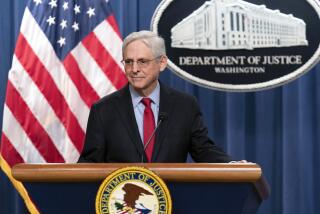Too-Broad Patenting of High Tech Points Up Patent Flaws in System
- Share via
Think America’s aspiring multimedia moguls are intimidated by powerbrokers like Microsoft’s Bill Gates, Tele-Communications Inc.’s John Malone or Creative Artists Agency’s Michael Ovitz? Maybe, a little. But the powerbrokers who really terrify the moguls these days are the technocrats at the U.S. Patent and Trademark Office.
Torn between nervous apprehension and disbelieving outrage, multimedia mavens from Boston’s Route 128 to San Francisco’s Multimedia Gulch were astounded by the patent office’s award of what appears to be a very broad, very basic patent to Compton’s New Media, a Carlsbad, Calif.-based multimedia company best known for its CD-ROM encyclopedia.
The patent effectively declares Compton’s the inventor of fundamental techniques in multimedia database search and retrieval--techniques that many in the field argue have been around for years.
As Philip Dodds, executive director of the Interactive Multimedia Assn., told the Los Angeles Times this week, “The patent office is granting these very general and broad patents without investigating or having any real knowledge of the technology or the marketplace.”
Then again, why should the multimedia folks be all that surprised? In August, the patent office shocked the financial services industry by awarding a comparably broad patent to tiny, Virginia-based Online Resources & Communications Corp., purportedly for inventing a fundamental process essential for any automatic teller machine operation.
What’s going on here? Why are seemingly basic patents being granted in the 1990s for techniques and technologies that apparently may be over 20 years old?
The fundamental challenge highlighted by broad patents such as the one granted to Compton’s New Media is the need to better determine--as patent law requires--just how “novel” and “non-obvious” an invention is. The greater the amount of “prior art” that underlies an invention, according to patent lawyers, the narrower and more limited the approved patent will be.
So because a lot of software companies sought intellectual property protection under copyright law instead of patents--and because a lot of innovative software was actually developed by the government and universities and is in the public domain--it’s understandable that patent examiners might not be aware of prior art in many key elements of software development.
“I’d be the first to say that (searching for prior art) is not a systematic process,” acknowledges Gerald Mossinghof, a former patent office chief who now heads the Pharmaceutical Manufacturers Assn.
The real root of the problem is that the patent application process is essentially a secret dialogue between inventor and the patent office that can go on for years while the rest of the world is busy innovating. But often at the end of that secret dialogue, however, out pops a patent that can turn an established industry on its head.
To be sure, as Mossinghof points out, you can always ask the patent office for a re-examination of a patent once it’s issued if you believe the government overlooked any relevant prior art. And, of course, you can go to court.
But both processes are time-consuming and expensive. What’s more, the mere award of the patent gives the “inventor” a patina of credibility. Why have a system that institutionalizes excess litigation?
There is a simple, inexpensive way the patent office and intellectual property policy-makers can better protect both inventors and existing marketplaces. Instead of simply awarding a patent, the patent office should announce--not unlike the way regulatory agencies issue new rules--that it is seeking comment on the patent it is about to issue.
The patent application--with all its claims--then would be published in the Federal Register and made available on the Internet.
For a period of, say, 60 days, the patent office would accept published and public papers (not scribblings in private notebooks) on prior art that might be relevant to the proposed patent. Interested parties wouldn’t be surprised. The patent office could then choose to modify or alter a patent being granted based on the information it received.
“This could reduce the amount of litigation with patents,” says patent attorney Peter Trzyna of Keck, Mahin & Cate. “In theory, fewer patents would be issued and the ones that were issued would be issued on the basis of better information.”
Indeed, Trzyna points out that pre-patent publication is required in many countries. In Japan, for instance, companies can file “oppositions” to proposed patents before a final patent is granted.
Former Patent Commissioner Donald W. Banner, who likes the notification concept but stresses that it must be conducted in an informational manner rather than with an eye toward litigation, points out that there’s already a precedent with trademark notification.
Yes, technology is evolving faster than the patent office can keep up with it. Yes, intellectual property protection is essential to innovation. But if we want to do a better job of rewarding real breakthroughs, the patent process has to become more public.
The nascent multimedia industry would be the first to agree.






